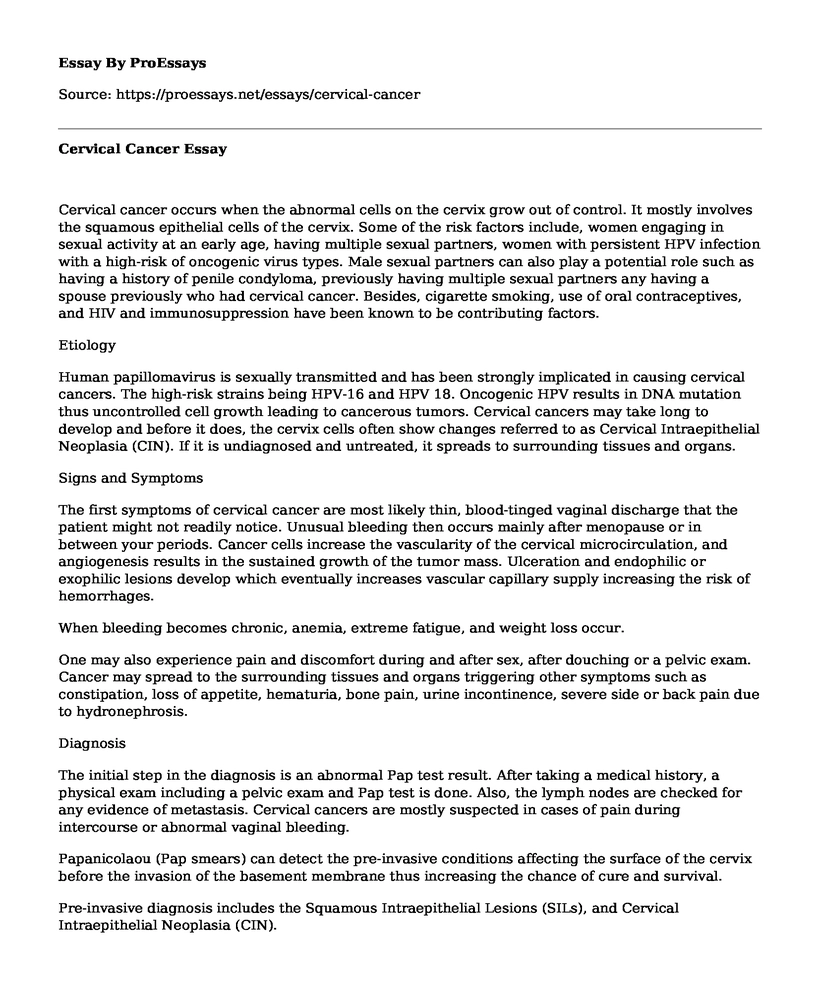Cervical cancer occurs when the abnormal cells on the cervix grow out of control. It mostly involves the squamous epithelial cells of the cervix. Some of the risk factors include, women engaging in sexual activity at an early age, having multiple sexual partners, women with persistent HPV infection with a high-risk of oncogenic virus types. Male sexual partners can also play a potential role such as having a history of penile condyloma, previously having multiple sexual partners any having a spouse previously who had cervical cancer. Besides, cigarette smoking, use of oral contraceptives, and HIV and immunosuppression have been known to be contributing factors.
Etiology
Human papillomavirus is sexually transmitted and has been strongly implicated in causing cervical cancers. The high-risk strains being HPV-16 and HPV 18. Oncogenic HPV results in DNA mutation thus uncontrolled cell growth leading to cancerous tumors. Cervical cancers may take long to develop and before it does, the cervix cells often show changes referred to as Cervical Intraepithelial Neoplasia (CIN). If it is undiagnosed and untreated, it spreads to surrounding tissues and organs.
Signs and Symptoms
The first symptoms of cervical cancer are most likely thin, blood-tinged vaginal discharge that the patient might not readily notice. Unusual bleeding then occurs mainly after menopause or in between your periods. Cancer cells increase the vascularity of the cervical microcirculation, and angiogenesis results in the sustained growth of the tumor mass. Ulceration and endophilic or exophilic lesions develop which eventually increases vascular capillary supply increasing the risk of hemorrhages.
When bleeding becomes chronic, anemia, extreme fatigue, and weight loss occur.
One may also experience pain and discomfort during and after sex, after douching or a pelvic exam. Cancer may spread to the surrounding tissues and organs triggering other symptoms such as constipation, loss of appetite, hematuria, bone pain, urine incontinence, severe side or back pain due to hydronephrosis.
Diagnosis
The initial step in the diagnosis is an abnormal Pap test result. After taking a medical history, a physical exam including a pelvic exam and Pap test is done. Also, the lymph nodes are checked for any evidence of metastasis. Cervical cancers are mostly suspected in cases of pain during intercourse or abnormal vaginal bleeding.
Papanicolaou (Pap smears) can detect the pre-invasive conditions affecting the surface of the cervix before the invasion of the basement membrane thus increasing the chance of cure and survival.
Pre-invasive diagnosis includes the Squamous Intraepithelial Lesions (SILs), and Cervical Intraepithelial Neoplasia (CIN).
The diagnostic tests done include endocervical scraping and colposcopy (with biopsy). A colposcope is used to examine the cervix. A weak acetic acid solution is added to the cervix for easier viewing of abnormal areas. A biopsy is then done involving removal of a small piece of tissue using a biopsy forceps from the area and studied microscopically.
Sometimes the transformation zone is not seen using a colposcopy. Hence endocervical scraping is done, this involves taking of scraping of endocervix from endocervical canal using a curette.
Other biopsies include cone biopsy whereby a cone-shaped piece of cervix tissue is removed. This can be used to remove precancers and early cancers.
Treatment
Treatment depends on how far cancer has spread. Pre-cancer cells are removed through cone biopsy, laser therapy and large loop excision of the transformation zone. The surgeries for cervical cancer includes;
Radical trachelectomy where the cervix, surrounding tissues, and upper vagina are removed. It is done if cancer is diagnosed earlier.
Hysterectomy that involves removal of the cervix and womb depending on cancer stage.
Pelvic exenteration in which the cervix, womb, vagina, fallopian tubes, bladder, ovaries, and rectum are removed. It is done if cancer returns to the pelvis after a treatment course.
Apart from the surgeries, therapies can also be done.Radiotherapy is done to destroy the cancerous cells despite having side effects like infertility, bladder damage, nausea, and diarrhea.
Chemotherapy can be used as a sole treatment to slow down advanced cancers and relieve symptoms.it is given using an intravenous drip. It has side effects such as nausea and vomiting, diarrhea, and hair loss.
Follow-up is important after treatment for testing to look out for signs of cervical cancer returning. Physical examination of the cervix and vagina are usually done.
References
Borruto, F., & De Ridder, M. (2012). HPV and Cervical Cancer. New York, NY: Springer New York.
Cancer.org,. (2015). Cervical Cancer | Learn About Cancer | American Cancer Society. Retrieved 2 December 2015, from http://www.cancer.org/cancer/cervicalcancer/
Chernecky, C., & Murphy-Ende, K. (2009). Acute care oncology nursing. St. Louis, Mo.: Saunders/Elsevier.
Huether, S., McCance, K., & Parkinson, C. (2013). Study Guide for Understanding Pathophysiology. London: Elsevier Health Sciences.
Cite this page
Cervical Cancer. (2021, Mar 06). Retrieved from https://proessays.net/essays/cervical-cancer
If you are the original author of this essay and no longer wish to have it published on the ProEssays website, please click below to request its removal:
- Etiology of Sickle Cell Anemia Essay
- Personal Reflection Essay - Cancer the Monster
- Cardiovascular System and Its Response to Acute and Chronic Exercise Paper Example
- Pharmaceutical Treatment of Hepatitis C Paper Example
- Finger Worth $2 Billion Essay Example
- Essay Sample on CVS Pharmacy: Understanding Customer Expectations
- Paper Sample on Preserving Privacy in Healthcare: Encouraging and Monitoring Patient Information







